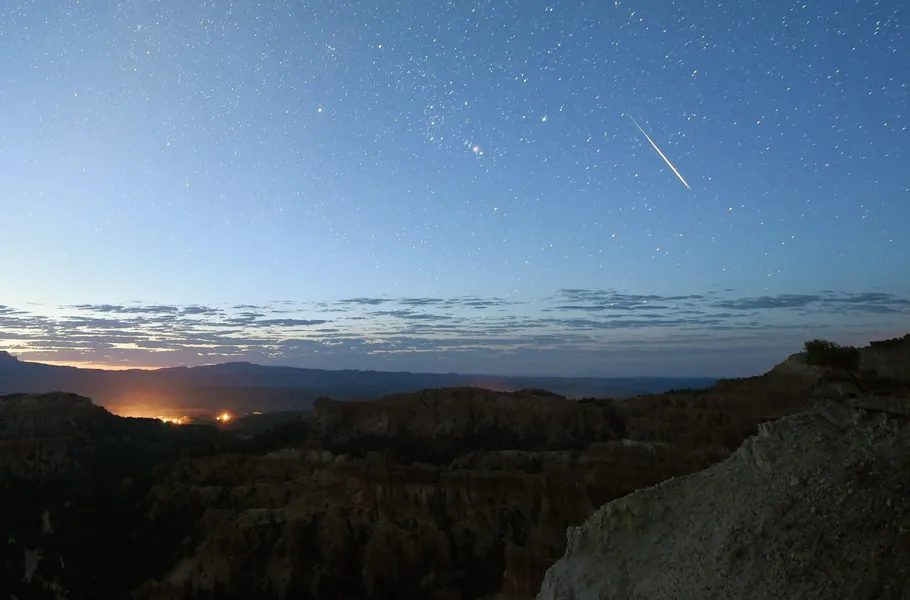
When To See ‘Shooting Stars’ Tonight As Four Meteor Showers Collide
How did your country report this? Share your view in the comments.
Diverging Reports Breakdown
When To See ‘Shooting Stars’ Tonight As Four Meteor Showers Collide
The Piscis Austrinid meteor shower will peak in the early hours of July 28, with about five meteors per hour possible. The following morning, July 29, will see the peaks of two more meteor showers, the Southern delta Aquariids and the alpha Capricornids. The best view will likely be had about 3:00 a.m. local time in North America (all timezones) when the radiant points of Pisces, Aquarius and CapricORN are highest in the sky. After the Perseids come to an end on Aug. 23, the next major meteor shower, the Orionids, will peak overnight on Oct. 22-23, one day after October’s new moon. The Orionids is one of two annual meteor showers caused by Halley’s Comet, the most famous and one of the largest comets known.
Summer’s “shooting stars” season gets underway this week with the peaks of three meteor showers. The most famous meteor shower of all, the Perseids, will peak on Aug. 12-13, but a badly timed full moon makes this week the best time to see its shooting stars.
Getty Images
Key Facts
The Piscis Austrinid meteor shower will peak in the early hours of July 28, with about five meteors per hour possible, according to In-The-Sky.org. The following morning, July 29, will see the peaks of two more meteor showers, the Southern delta Aquariids and the alpha Capricornids. The Southern delta Aquariid meteor shower produces up to 25 shooting stars per hour, with most being rather faint. Although the alpha Capricornids number just five shooting stars per hour at their peak, they tend to include bright and colorful fireballs, according to the American Meteor Society. For all three meteor showers, the best view will likely be had about 3:00 a.m. local time in North America (all timezones), when the radiant points — the constellations of Pisces, Aquarius and Capricorn — are highest in the sky. Those constellations are all visible low on the southern horizon, so the best views will be had the farther south in North America. July 28 and 29 will be excellent nights for stargazing and looking for shooting stars if the skies are clear because the light from the crescent moon will not bleach the night sky.
What To Know About The Perseid Meteor Shower In 2025
The Perseid meteor shower is already active, having begun on July 17 and is expected to continue until Aug. 23. On the peak night, around 50-75 meteors per hour are visible, but in 2025, that number will be significantly reduced, with only the very brightest of its shooting stars visible. That’s because Aug. 9 will see the rise of a full sturgeon moon, which will remain bright and dominant in the night sky on Aug. 12-13, rising just as the peak of the Perseids gets underway. It will remain in the sky for the rest of the night.
When To See The Perseid Meteor Shower In 2025
There are two periods to watch the skies in 2025 if you want to see shooting stars from the Perseid meteor shower. The first is right now before the moon reaches its first quarter phase on Aug. 1. The second is Aug. 15, when the moon will rise around midnight and a little later on subsequent nights.
How To Watch A Meteor Shower
According to NASA, the best way to watch a meteor shower is to get out of the city to the darkest location you can, such as a Dark Sky Place. However, it’s wise to check the weather forecast in advance because a clear sky is imperative. Observe somewhere with a clear view of as much of the night sky as possible, with extra layers to keep warm, as well as bug spray, snacks and drinks. Be patient, take a break every 30 minutes and avoid looking at a smartphone whose white light will kill your night vision.
The Next Major Meteor Shower
After the Perseids come to an end on Aug. 23, the next major meteor shower will be the Orionids. Active from Oct. 2 to Nov. 12, it will peak overnight on Oct. 22-23, one day after October’s new moon. That will be perfectly dark skies, making many of the Orionids’ predicted 10-20 shooting stars per hour during the peak visible to observers away from light pollution. The Orionid meteor shower is one of two annual meteor showers caused by Halley’s Comet, the most famous and one of the largest comets known. The other is the Eta Aquariids meteor shower, which next peaks on May 5-6, 2026.
Further Reading
Forbes NASA Urges Public To Leave The City As Milky Way Appears — 15 Places To Go
Forbes Get Ready For The Shortest Day Since Records Began As Earth Spins Faster
